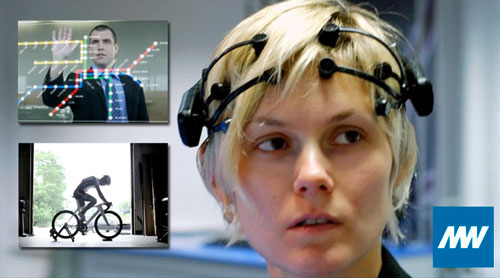The marketing services sector is in a state of flux. Brand owners face increasing difficulties in selecting agencies and agencies are struggling to define and position themselves. Evidently, the complexity is set to increase.
In addition to the many short term fads, there are bigger, macro trends looming that will make it even more difficult for marketers and their agencies to focus. Some of them are weird in the extreme…
5. Implicit Interactions
 Some of us can still remember the first ‘one click’ mouse that made controlling a personal computer more straightforward. Since then, the arc of innovation has resulted in our relationship with technologies being founded on increasingly implicit means. Touch superseded type. Voice superseded touch. Then physical means became possible, using gesture, expression and posture. Today, we are controlling technology via increasingly natural and instinctive methods. How we stand and how we walk are now means by which we can convey our needs and wants. So, just as marketers have grasped the notion of a ‘user interface’ it is becoming old school. Freakier still, the prospect of having no perceptible conduit between technology and us is not just plausible, it is now viable. Perhaps the pinnacle of this evolution is the use of neural sensors, providing so much more than just greater user convenience. These new means of interaction are not just utilitarian. They affect how, when and indeed why we purchase good and services. Moreover, whether we’re buying a mortgage or ordering a pizza, they fundamentally change how we think about brands and customer service.
Some of us can still remember the first ‘one click’ mouse that made controlling a personal computer more straightforward. Since then, the arc of innovation has resulted in our relationship with technologies being founded on increasingly implicit means. Touch superseded type. Voice superseded touch. Then physical means became possible, using gesture, expression and posture. Today, we are controlling technology via increasingly natural and instinctive methods. How we stand and how we walk are now means by which we can convey our needs and wants. So, just as marketers have grasped the notion of a ‘user interface’ it is becoming old school. Freakier still, the prospect of having no perceptible conduit between technology and us is not just plausible, it is now viable. Perhaps the pinnacle of this evolution is the use of neural sensors, providing so much more than just greater user convenience. These new means of interaction are not just utilitarian. They affect how, when and indeed why we purchase good and services. Moreover, whether we’re buying a mortgage or ordering a pizza, they fundamentally change how we think about brands and customer service.
4. Embedded Transactions
 Transactions have traditionally been something we need to stop for; to consider and deliberate as an adjunct to our daily routines. Another fundamental trend for marketers to be aware of is that of transactions – of all kinds – becoming intrinsic and integral to the customer experience. Consider the humble Kindle. Not only does it undermine the physical bookstore, it also integrates the online store within the product and vice versa. It consequently makes cognitive and purchasing decision cycles swifter and more instinctive. Further, it changes your relationship with the vendor and your fellow consumers. From the privacy of your personal device, you are in many ways less affected by your peers when making a buying decision, a phenomenon that surely contributed to the uptick in sales of erotica. You are also more beholden to the store owner, who has an intimate knowledge of your (dubious) tastes.
Transactions have traditionally been something we need to stop for; to consider and deliberate as an adjunct to our daily routines. Another fundamental trend for marketers to be aware of is that of transactions – of all kinds – becoming intrinsic and integral to the customer experience. Consider the humble Kindle. Not only does it undermine the physical bookstore, it also integrates the online store within the product and vice versa. It consequently makes cognitive and purchasing decision cycles swifter and more instinctive. Further, it changes your relationship with the vendor and your fellow consumers. From the privacy of your personal device, you are in many ways less affected by your peers when making a buying decision, a phenomenon that surely contributed to the uptick in sales of erotica. You are also more beholden to the store owner, who has an intimate knowledge of your (dubious) tastes.
Embedded transactions are not restricted to buying stuff. Transport and security are areas where permissions and privileges are granted using embedded transactions. Toll roads, schoolyards and airports are making previously overt and time consuming transactions quicker and often imperceptible. Put simply, NFC chips in your shoes will literally mean you can vote – and purchase – with your feet. There are profound consequences, which marketers need to be aware of, with social, commercial and legal dimensions.
3. Distorting Space and Time
 Your bedroom is the new living room. Sometimes my office is a train. My sister can run an international retail business from her home. I can watch tomorrow’s TV on my phone today. While I’m on vacation, I can check that my house is secure thousands of miles away. Technology is conflating previously distinct physical places and messing with scheduling conventions. It’s all very Dr Who and there are important considerations for marketers. It will be increasingly difficult to plan campaigns in a linear, chronological manner. Furthermore, when profiling, marketers they will need to embrace the idea of geo-psychographics, whereby consumers are segmented not just by their economic status and general propensity to buy but also by their specific location and state of mind.
Your bedroom is the new living room. Sometimes my office is a train. My sister can run an international retail business from her home. I can watch tomorrow’s TV on my phone today. While I’m on vacation, I can check that my house is secure thousands of miles away. Technology is conflating previously distinct physical places and messing with scheduling conventions. It’s all very Dr Who and there are important considerations for marketers. It will be increasingly difficult to plan campaigns in a linear, chronological manner. Furthermore, when profiling, marketers they will need to embrace the idea of geo-psychographics, whereby consumers are segmented not just by their economic status and general propensity to buy but also by their specific location and state of mind.
2. Teaching and Learning
 Technology is increasingly being deployed to learn about us and to teach us. Algorithms are predicting and pre-empting the needs and wants of consumers. There’s already a proliferation of behavioral analytics tools and recommendation engines such as TheFilter.com. Devices for children and infants are offered as supplements to parenting. As I write, a key player in this sector, LeapFrog has a market cap of over $500m. Utilities companies and telcos are monitoring their customers’ homes, in an attempt to add value to their commoditized core product. AT&T and British Gas have already put a big pile of their chips on the table. And finally, there’s a rapid growth in what we can immediately recognize as teaching ‘n’ learning in the form of online educational services. These range from mundane instruction to serious academic study.
Technology is increasingly being deployed to learn about us and to teach us. Algorithms are predicting and pre-empting the needs and wants of consumers. There’s already a proliferation of behavioral analytics tools and recommendation engines such as TheFilter.com. Devices for children and infants are offered as supplements to parenting. As I write, a key player in this sector, LeapFrog has a market cap of over $500m. Utilities companies and telcos are monitoring their customers’ homes, in an attempt to add value to their commoditized core product. AT&T and British Gas have already put a big pile of their chips on the table. And finally, there’s a rapid growth in what we can immediately recognize as teaching ‘n’ learning in the form of online educational services. These range from mundane instruction to serious academic study.
This might seem like a wildly disparate collection but there is a common thread; the trading of insight or knowledge. Acquisition and retention programs – what we once called Customer Relationship Marketing – will be increasingly affected by this trend. Banal Twittering and thinly veiled sales promotions on Facebook are just not going to cut the mustard.
1. Consumers as Processors & Producers
 Perhaps the most significant and weirdest trend is also the most varied and wide reaching. It’s a trend of fundamental significance because it concerns value chains; the devolution and dispersion of power in the marketplace. This meta-trend has three facets. Firstly, consumers’ ideas are influencing and affecting business and government more directly. Consumers can affect changes in revenues and reputations quickly and easily via social networks. Secondly, they are increasingly able to distribute products and services independently using trading sites like Ebay, Fiverr and Alibaba. Thirdly, they can ‘manufacture’ in the broadest sense. Using affordable tools to produce content, software and even tangible products with 3D printers, consumers are able to do more than just consume, they can can now create.
Perhaps the most significant and weirdest trend is also the most varied and wide reaching. It’s a trend of fundamental significance because it concerns value chains; the devolution and dispersion of power in the marketplace. This meta-trend has three facets. Firstly, consumers’ ideas are influencing and affecting business and government more directly. Consumers can affect changes in revenues and reputations quickly and easily via social networks. Secondly, they are increasingly able to distribute products and services independently using trading sites like Ebay, Fiverr and Alibaba. Thirdly, they can ‘manufacture’ in the broadest sense. Using affordable tools to produce content, software and even tangible products with 3D printers, consumers are able to do more than just consume, they can can now create.
Granted, there will always be the cart-pushing monkeys at the bottom of the digital food chain who can still be trained with trinkets and treats. But here’s the thing… they’re more likely to follow the intelligent, emancipated consumers who are merely irritated by ham-fisted marketing.
Enough trends, already.
Clearly, this list of trends is not comprehensive. What’s more, the five that I’ve highlighted are not mutually exclusive. The key take out is that thinking about fundamental shifts in the marketplace is not an intellectual indulgence. Imagining very different ways of engaging with customers profitably is not a distraction from our day-to-day business. It’s essential.

